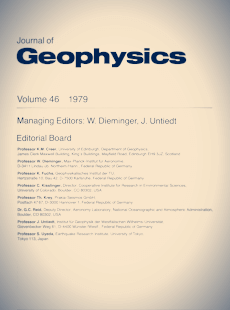Long-wavelength magnetic anomalies as a source of information about deep crustal structure
Article Sidebar

Vols. 1-18 (1924-1944), ISSN 0044-2801
Main Article Content
Abstract
The nature of long-wavelength magnetic anomalies (λ = 60–300 km) computed for the Ukrainian Shield from the original field by a continuation upward to a height of 10 km is studied. The correlation betweeen the regional anomalies, the crustal thickness and the topography of the Curie isotherm of magnetite is examined. The strongest correlation is established between the regional anomalies and the crustal thickness. Similar results have been obtained by us for the Baltic Shield and by D.H. Hall for the Canadian Shield. It is concluded that the entire lower crust is magnetized, the average magnetization being almost the same for all the ancient shields. These results have been used for the construction of a magnetic model of the Earth's crust. With some exceptions, the magnetization of the lower crust is found to be inhomogeneous and 5-10 times higher than that of the upper crust. Theoretical modelling and experimental results show a high magnetization in the entire sequence of blocks for the case of a thickened crust and, vice versa, weakly magnetized rocks correspond to a smaller thickness of the crust. The present approach may be of potential use for distinguishing and studying crust-upper mantle interaction areas as well as for predicting the topography of the Moho discontinuity.
 ARK: https://n2t.net/ark:/88439/y092937
ARK: https://n2t.net/ark:/88439/y092937
Permalink: https://geophysicsjournal.com/article/282
Article Details
References
Christencen, N.l., Fountain, D.M. (1975) Constitution of the lower continental crust based on experimental studies of seismic velocities in granulite. Geol. Soc. Am. Bull. 86:227-234
Dortman, N.B. (1976) Effect of thermodynamical conditions of formation on magnetic characteristics of the intrusive rocks (in Russian). In: Magnetic anomalies of the Earth's interior. Naukova
Dumka, Kiev
Green, A.G. (1976) Interpretation of project Magnet aeromagnetic profiles across Africa. Geophys. J. 44:203-228
Hall, D.H. (1974) Long-wavelength aeromagnetic anomalies and deep crustal magnetization in Manitoba and Northwestern Ontario, Canada. J. Geophys. 40:403-430
Kalyaev, G.I. (1976) The most ancient stage of continental crust formation (in Russian). Geofiz. Sbornik, No. 73:56-60
Krutikhovskaya, Z.A. (1976) Problems of creating the Earth's crust magnetic model for ancient shields (in Russian). Geofiz. Sb. No. 73:3-29
Krutikhovskaya, Z.A., Pashkevich, I.K., and Simonenko, T.N. (1973) Magnetic anomalies of Precambrian shields and some problems of their geological interpretation. Can. J. Earth Sci. 10:629-636
Krutikhovskaya, Z.A., Pashkevich, I.K. (1974) Magnetic field and structure of the Earth's crust for ancient shields (in Russian). Geofiz. Sb. No. 62:3-15
Krutikhovskaya, Z.A., Pashkevich, I.K. (1976) Is the crust of the ancient shields and platforms magnetized? (in Russian). Geofiz. Sb. No. 71:89-91
Kutas, R.I. (1976) Temperature distribution in the Earth's crust for the territory of the Ukrainian SSR(in Russian). Geofiz. Sb. No. 70:86-94
Kutas, R.I. (1977) A thermal model for the Earth's crust of the Ukrainian Shield along DSS line VIII (in Russian). Geofiz. Sb. No. 80 (In press)
Nalivkina, E.B. (1976) Petrological model of the Baltic Shield eastern part (in Russian). Geofiz. Sb. No. 73:46-55
Pashkevich, I.K. (1976) Procedure of distinguishing and interpretation of regional magnetic anomalies (In Russian). Geofiz. Sb. No. 73:30-36
Pavlenkova, N.I. (1973) Velocity fields and Earth's crust model (in Russian). Naukova Dumka, Kiev
Riddihough, R.P. (1972) Regional magnetic anomalies and geology in Fennoscandia. A discussion. Can. J. Earth Sci. 9:219-232
Semyonova, S.G. (1973) Relationship between physical properties, mineralogical composition and structural factors (in Russian). Geofiz. Razved., No. 57:128-136
Sollogub, V.B., Chekunov, A.V. (1975) Deep structure and Earth's crust evolution (in Russian). In: The Earth's physics problems in the Ukraine. Naukova Dumka, Kiev 118-141
Vogel, A., Lund, C.E. (1970) Combined interpretation of the Trans-Scandinavian seismic profile, section 2-3, University of Uppsala, Report 4, Uppsala











